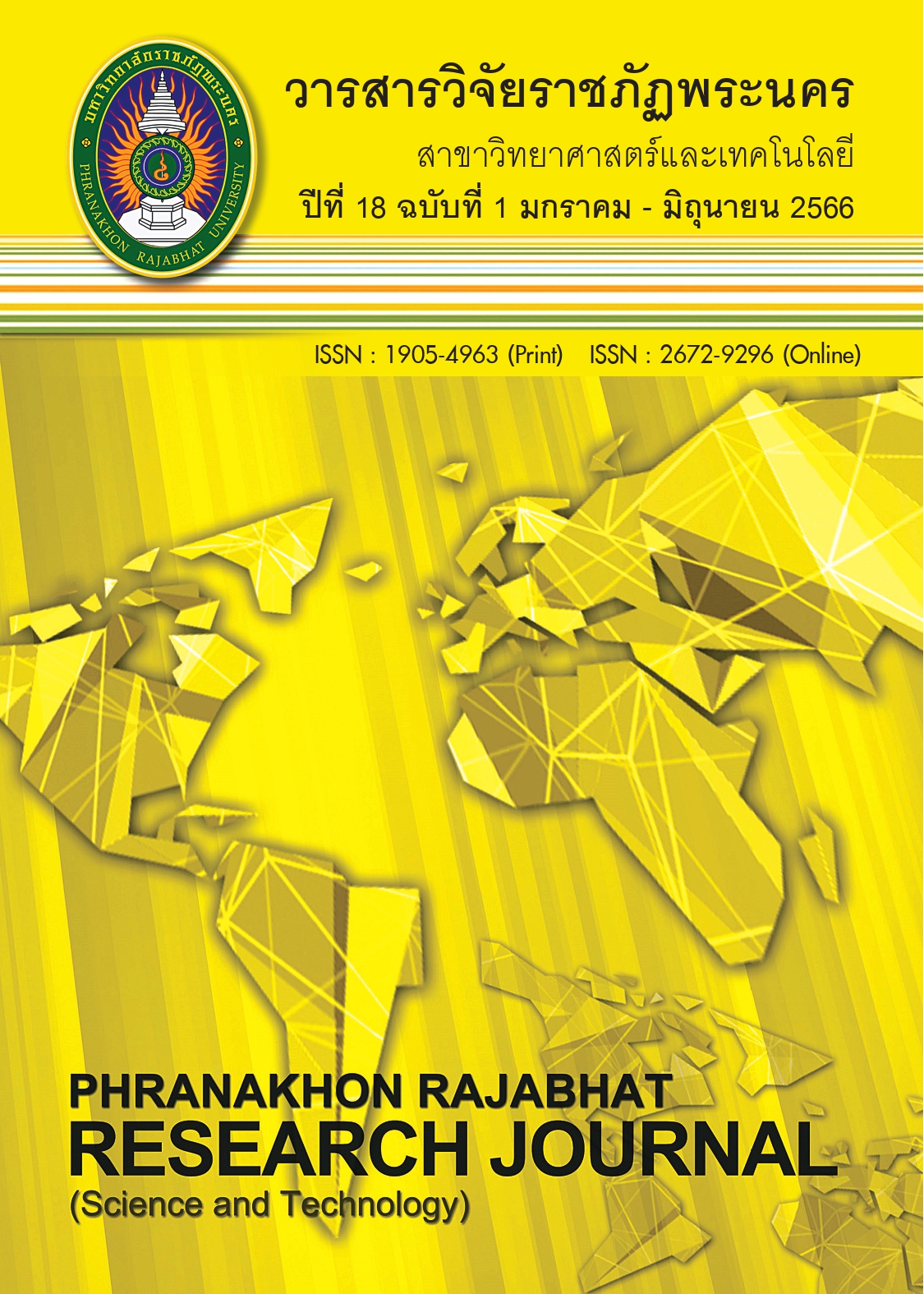EFFECT OF ERI SILKWORM PUPA POWDER ON QUALITY CHANGES OF BROWNIES
Keywords:
Eri silk pupae, Antioxidant, Total phenolic content, BrownieAbstract
This research aims to study the effect of Eri silkworm pupa powder on the physical properties, chemical composition, and sensory liking of brownies. It was found that Eri silkworm pupa powder had a light brown color and a fine powder consistency. The measured color values L*, a*, and b* were 42, 0.40, and 5.32, respectively. The moisture content, determined using a moisture analyzer and a hot air oven, was 5.02% and 5.20%, respectively. Carbohydrates, proteins, fats, dietary fiber, and ash contents of Eri silkworm pupa powder were 0.025%, 72.77%, 16.51%, 4.75%, and 5.66% of the total, while water activity (AW) was 0.55. The bioactive compounds, including antioxidants and phenolic compounds, were found to be 44.09 mg Trolox equivalent/g and 8.41 mg Gallic equivalent/100g, respectively. Eri silkworm pupa powder was incorporated into brownies, replacing wheat flour at levels of 0, 10, 20, 30, and 40% of the starch weight. In sensory evaluations, the brownies containing 10% Eri silkworm pupa powder received the highest rating in overall preference, with L*, a*, and b* values of 39.47, 0.85, and 2.22, respectively. The firmness was determined to be 94.28 N. The chemical composition of the product, in terms of carbohydrates, moisture, ash, free water content, protein, fat, and fiber, was found to be 31.82%, 16.92%, 1.14%, 0.87%, 10.29%, 32.73%, and 2.91%, respectively. After storage for 6 days, the brownies contained antioxidants and phenolic compounds equivalent to 43.61 mg Trolox eq./g and 3.02 mg Gallic eq./100g.
References
Anson, N.M., van den Berg, R., Havenaar, R., Bast, A., & Haenen, G.R.M.M. (2009). Bioavailability of ferulic acid is determined by its bioaccessibility. Journal of Cereal Science, 49, 296-300.
AOAC. (2000). Official Methods of Analysis. 17th Edition, The Association of Official Analytical Chemists, Gaithersburg, MD, USA. Methods 925.10, 65.17, 974.24, 992.16.
Attatham, T. (2021). Erie silk road to green Industry promotion. Research Community, 93, 9.
Boonsean, S., Boonbai, N., Poonyim, S., Sirisubjareon, A., Ngamnikom, P., & Surin, S. (2021). Development of Healthy Brownie from Three Colored Beans. Research Journal Rajamangala University of Technology Thanyaburi, 20(1), 30–39.
Butkhup, L., Jeenphakdee, M., Jorjong, S., Samappito, S., Samappito, W., & Butimal, J. (2012). Phenolic composition and antioxidant activity of Thai and Eri silk sericins. Food Science and Biotechnology, 21, 10.1007/s10068-012-0050-0.
Chodnakarin, A., Phugan, P., Inket, S., Sam-ang, P., & Jansukon, E. (2021). Effects of wheat flour substitution with Hom Nin broken rice flour on quality changes of brownie. Christian University Journal, 27(1), 84–96.
Ekpo, K.E., & Onigbinde, A.O. (2005). Nutritional potentials of the larvae of Rhynchophorus phoenicis. Pakistan Journal of Nutrition, 4, 287–290.
Fuengkajomfung, N. (2023). Effect of various colored rice flours on the quality of cricket protein powder fortified chiffon cake. Christian University Journal, 29(1), 68-79.
Gallagher, E. (2009). Gluten-Free Food Science and Technology (1st ed.). Oxford: Wiley-Blackwel.
Iqbal, S., Bhanger, M.I., & Anwar, F. (2005). Antioxidant properties and components of some commercially available varieties of rice bran in Pakistan. Food Chemistry, 93(2), 265–272.
Jammek, J., & Naivikul, A. (1982). Introduction to Bakery Technology. (2nd ed.). Kasetsart University. Faculty of Agro-Industry.
Jintasataporn, O., Tabthipwon, P., & Ohshima, Y. (2001). Chemical composition, lipid class and fatty acid composition of Eri Silkworm (Philosamia ricini Boisd). Proceeding of The JSPS 70th International commemorative symposium (pp. 1637–1638). Tokyo, Japan.
Jonjaitet, N., Yinglerrattanakul, P., Phammuang, P. & Phungphan, W. (2007). Trans fat content in baked and fried foods (Research Report). Bangkok: Division of Nutrition, Department of Health, Ministry of Public Health.
Longvah, T., Mangthya, K., & Ramulu, P. (2011). Nutrient composition and protein quality evaluation of eri silkworm (Samia ricinii) prepupae and pupae. Food Chemistry, 128, 400–403.
Malaisse, F., & Parent, G. (1980). Les chemilles comestibles du shaba meridional (Zaire). Naturalistes Beges, 61, 2–24.
Nowak, V., Persijn, D., Rittenschober, D., & Charrondiere, U. R. (2016). Review of food composition data for edible insects. Retrieved from https://doi.org/10.1016/j.foodchem.2014.10.114 [2023, 12 Jan.]
Ploenchit, J. (2012). Stability of phenolic-acids in subcritical water (Research report). Nakronprathom: Silpakorn University.
Pongpien, W. (2008). The study of the properties of antioxidants and all phenolic compounds in the hatch (Master's thesis). Phetchabun: Phetchabun Rajabhat University.
Pratumsri, N., Tabtipwan, P., Jintastaporn, O., & Srisapom, P. (2009). Use of protein hydrolysate from Erie silkworm. (Philosamia ricini, Boisd) substitutes fishmeal in hybrid catfish feed (Clarias macrocepharus x Clarias gariepinus). 47th: Fisheries. Kasetsart University Academic Conference (pp. 154–161). Thailand Research Fund.
Purlis, E. (2010). Browning development in bakery products. Journal of Food Engineering, 99(3), 239-249.
Rao, P.U. (1994). Chemical composition and nutritional evaluation of spent silkworm pupae. Journal of Agricultural and Food Chemistry, 42, 2201–2203.
Sengupta, S., Choudhury, K., Bhattacharya, I. K., & Choudhury S.K. (1995). Effect of feeding muga silk worm pupae waste as a substitute of fishmeal in broiler ration. Indian Journal of Animal Sciences, 65(7), 827–829,
Sheikh, I.U., Banday, M.T., Baba, I.A., Adil, S., Shaista, S., Nissa, Bushra Zaffer & KH Bul, K.H. (2018). Utilization of silkworm pupae meal as an alternative source of protein in the diet of livestock and poultry: A review. Journal of Entomology and Zoological studies, 6(4),1010–1016.
Sinchaipanit, P., Budpong, K., Disnil, S., & Twichatwitayakul, R. (2017). Influences of rice berry flour as a wheat flour substitute in brownie: textural and quality attributes. SDU Research Journal Humanities and Social Sciences, 10(2), 69-80.
Sirichokworrakit, S., Intasen, P., & Angkawut, C. (2016). Quality of donut supplemented with Hom Nin rice flour. International Scholarly and Scientific Research & Innovation, 10(7), 443-446.
Downloads
Published
Issue
Section
License

This work is licensed under a Creative Commons Attribution-NonCommercial-NoDerivatives 4.0 International License.
โปรดกรอกเอกสารและลงนาม "หนังสือรับรองให้ตีพิมพ์บทความในวารสารวิจัยมหาวิทยาลัยราชภัฏพระนคร สาขาวิทยาศาสตร์และเทคโนโลยี" ก่อนการตีพิมพ์




